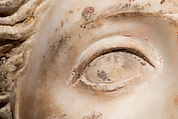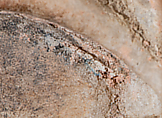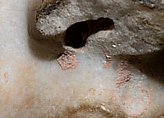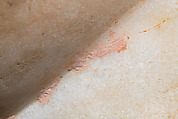Returned to lender The Met accepts temporary loans of art both for short-term exhibitions and for long-term display in its galleries.
Study 1 of the color scheme of the so-called Treu Head
Vinzenz Brinkmann German
Ulrike Koch-Brinkmann
Not on view
A Roman head carved of Parian marble has played a fundamental role in the history of ancient polychromy studies since the late nineteenth century, when German archaeologist Georg Treu published his investigations of its preserved color. Once set into a statue of the goddess Minerva or Venus, the head retains extensive pigment traces, including those used for flesh tones, which are rarely found today. More recently, conservation scientist Giovanni Verri and his colleagues analyzed the surviving paint using noninvasive imaging techniques and other analytical methods. The results informed the two reconstructions of the head’s ancient polychromy exhibited here; each presents a distinctive interpretation of the original painting processes and preserved color.
"The so-called Treu Head in the British Museum, which probably represents a goddess, was found in Rome in the 1880's. The head is finished and painted only on the front side, because it was inserted into a larger-than-life sculpture, which was made of a different material.
Extraordinarily rich traces of paint are preserved on the skin and hair, more than any other ancient marble sculpture. In 2010, Giovanni Verri and Thorsten Opper of the British Museum did a thorough investigation of the pigments and the painting techniques of the head. The initial studies for a reconstruction were carried out based on the results of their research.
On the highly polished marble surface of the work, traces of large areas of pigment applied evenly over the skin have been preserved. A black preparatory drawing outlined the eyes, iris, and pupils and defined the eyebrows (as can be seen in the left side of the face in the study). The eyes were rendered with a glowing mixture of lead white and Egyptian blue, the tear ducts in pink madder. The color of the iris has not been preserved. Intense remains of Egyptian blue are in the upper part of the eye white, they could indicate a painted shadow. Such bluish shadows can often be observed in the eyes of terracotta statuettes. Madder lake was also employed for the nostrils and the interior of the mouth. For the rosy colored skin a complex mixture of calcium carbonate, hematite, goethite, and Egyptian blue was used. The upper and lower eyelids are modeled with madder lake. Highlights, applied with white calcite, are preserved on the right cheek. Black lines of shading sit at the corners of the mouth. The hair was painted yellow, with a painterly modeling of the strands in red ocher (as can be seen in the right side of the face in the study reconstruction). Both the color palette and stylistic features correspond to contemporary panel painting, aiming to achieve a strikingly naturalistic effect. As important as the comparison with the painting of the mummy portraits is for the understanding of the color remains of the Treu head, there is one very serious difference to be noted: This is the painting of a three-dimensional object, which must take into account the shadows cast by natural light. These shadows also change, for example, with the course of the sun.
It is remarkable that the Treu Head was not cleaned following its discovery, as was the usual practice at the time. As a result, the clear evidence for an evenly applied skin tone over the entire face is of central importance for our basic understanding of the polychromy of ancient statuary."
Vinzenz Brinkmann and Ulrike Koch-Brinkmann
Experimental study 1, 2014 (2022 recreated after loss in 2021):
Vinzenz Brinkmann and Ulrike Koch-Brinkmann
marble stucco on a plaster cast after a 3-D scan, natural pigments (chromatographically calibrated) in egg tempera
H. 37 cm.
Liebieghaus Skulpturensammlung (Liebieghaus Polychromy Research Project), Frankfurt am Main, inv. Dep.64
Scientific methods employed:
Optical stereoscopic microscopy (10–50x, Zeiss and Olympus),
Raking light imaging (Schott KL1500)
Visible-reflected imaging in black and white (VIS)
Visible-reflected imaging in color (VIS)
Photomicrograph (with microscope or macro objectives)
Ultraviolet-visible absorption spectroscopy (UV-Vis spectroscopy)
For further methods see: Verri, Giovanni, Thorsten Opper and Thibaut Deviese. 2010
Scientific evaluation:
Vinzenz Brinkmann, Ulrike Koch-Brinkmann, Heinrich Piening
Pigments employed for the study:
red: red iron oxide, hematite, cinnabar; pink: madder, calcite; yellow: yellow iron oxide, goethite; white: lead white, calcite; blue: Egyptian blue; black: soot; skin tone: calcite, yellow and red iron oxide, Egyptian blue
Acknowledgements:
Thorsten Opper
The British Museum, London
Due to rights restrictions, this image cannot be enlarged, viewed at full screen, or downloaded.
This artwork is meant to be viewed from right to left. Scroll left to view more.






.jpg)




.jpg)

